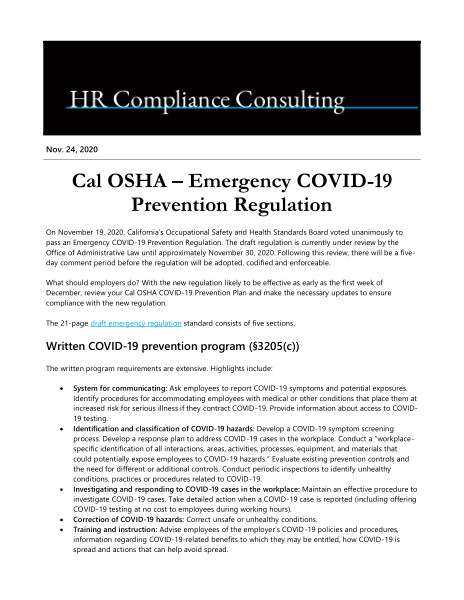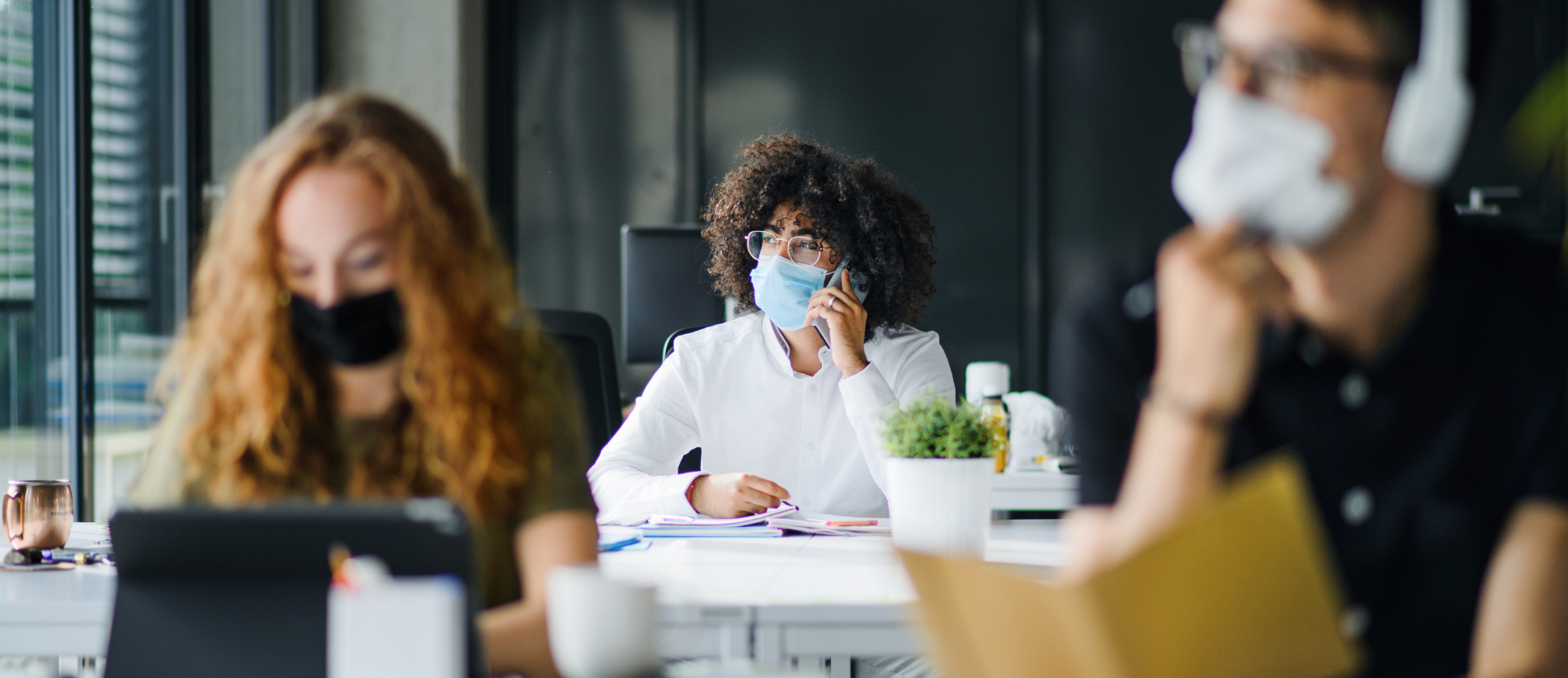On November 19, 2020, California’s Occupational Safety and Health Standards Board voted unanimously to pass an Emergency COVID-19 Prevention Regulation. The draft regulation is currently under review by the Office of Administrative Law until approximately November 30, 2020. Following this review, there will be a five-day comment period before the regulation will be adopted, codified and enforceable.
What should employers do? With the new regulation likely to be effective as early as the first week of December, review your Cal OSHA COVID-19 Prevention Plan and make the necessary updates to ensure compliance with the new regulation.
The 21-page draft emergency regulation (opens a new window) standard consists of five sections.
Written COVID-19 prevention program (§3205(c))
The written program requirements are extensive. Highlights include:
System for communicating: Ask employees to report COVID-19 symptoms and potential exposures. Identify procedures for accommodating employees with medical or other conditions that place them at increased risk for serious illness if they contract COVID-19. Provide information about access to COVID-19 testing.
Identification and classification of COVID-19 hazards: Develop a COVID-19 symptom screening process. Develop a response plan to address COVID-19 cases in the workplace. Conduct a “workplace-specific identification of all interactions, areas, activities, processes, equipment, and materials that could potentially expose employees to COVID-19 hazards.” Evaluate existing prevention controls and the need for different or additional controls. Conduct periodic inspections to identify unhealthy conditions, practices or procedures related to COVID-19.
Investigating and responding to COVID-19 cases in the workplace: Maintain an effective procedure to investigate COVID-19 cases. Take detailed action when a COVID-19 case is reported (including offering COVID-19 testing at no cost to employees during working hours).
Correction of COVID-19 hazards: Correct unsafe or unhealthy conditions.
Training and instruction: Advise employees of the employer’s COVID-19 policies and procedures, information regarding COVID-19-related benefits to which they may be entitled, how COVID-19 is spread and actions that can help avoid spread.
Physical distancing: Separate employees from other persons by at least 6 feet, except where not possible and for momentary exposure while in movement.
Face coverings: Provide face coverings to employees and ensure they are worn with limited exceptions.
Other engineering controls, administrative controls and personal protective equipment: Includes installing cleanable solid partitions when physical distancing is not possible, maximizing the quantity of outside air indoors, implementing cleaning and disinfecting policies, evaluating handwashing facilities and providing hand sanitizer, and evaluating the need for additional PPE.
Exclusion of COVID-19 cases and those with exposure: Continue and maintain an employee’s earnings, seniority and all other employee rights and benefits. Employers may use employer-provided employee sick leave benefits and consider benefit payments from public sources in determining how to maintain earnings, rights and benefits where permitted by law and when not covered by worker’s compensation
Return to work criteria for COVID-19 cases: A minimum of 10 days must pass since symptoms or positive COVID-19 test. A negative COVID-19 test cannot be required.
Multiple COVID-19 infections and COVID-19 outbreaks (§3205.1)
This applies to employers identified by a local health department as the location of a COVID-19 outbreak or when there are three or more COVID-19 cases in an exposed workplace within a 14-day period. It applies until there are no new COVID-19 cases detected for a 14-day period. Highlights include:
Detailed testing requirements: Employer shall provide COVID-19 testing to all exposed employees at no cost to the employee during working hours. Testing is repeated one week later. Negative test results of employees with COVID-19 exposure does not change the duration of the required quarantine period. Following the first two COVID-19 tests, employers shall provide continuous COVID-19 testing of employees who remain at the workplace at least once a week, or more frequently if recommended by the local health department.
Investigation of illness: Employer shall investigate and determine possible workplace-related factors that contributed to the COVID-19 outbreak (i.e., insufficient outdoor air, insufficient air filtration, lack of physical distancing). Consider moving indoor tasks outdoors.
Notify local health department: Notice is required no later than 48 hours after the employer knows or should have known with diligent inquiry of three or more COVID-19 cases for guidance on preventing further spread.
Major COVID-19 outbreaks (§3205.2)
This applies when there are 20 or more COVID-19 cases in an exposed workplace within a 30-day period. Highlights include:
Detailed testing requirements: Employers shall provide COVID-19 testing twice a week (or more frequently if recommended by local health authority) at no cost to exposed employees during working hours.
Exclude employees with COVID-19 and those exposed.
COVID-19 hazard correction: In buildings or structures with mechanical ventilation, employers shall filter recirculated air with Minimum Efficiency Reporting Value (MERV) 13 or higher efficiency filters if compatible with the ventilation system; evaluate whether portable or mounted High Efficiency Particulate Air (HEPA) filtration units would reduce the risk of transmission and implement if feasible. Consider a respiratory protection program. Evaluate whether to halt some or all operations.
COVID-19 prevention in employer-provided housing (§3205.3)
This applies to housing that is arranged for or provided by an employer to workers in connection with the workers’ employment. This is not applicable to housing provided for emergency responders. Highlights include:
Assignment of housing: Family members should be housed in the same unit without others. Crew members should be housed in the same housing unit.
Physical distancing and controls: Ensure at least 6 feet of physical distance between residents. Beds should be spaced at least 6 feet apart to maximize the distance between sleepers’ heads. Maximize the quantity and supply of outdoor air and increase filtration efficiency to the highest level compatible with existing ventilation system.
Face coverings: To be provided by employers to all residents.
Cleaning and disinfecting: Clean and disinfect at least once a day.
Screening: Encourage residents to report COVID-19 symptoms to employer.
COVID-19 testing: Establish, implement and maintain effective COVID-19 testing policies for those with exposure to or symptoms of COVID-19.
Isolation of COVID-19 cases and those exposed: Isolate from all other occupants.
COVID-19 prevention in employer-provided transportation to and from work (§3205.4)
This applies to employer-provided transportation to and from work including ride-share vans or shuttle vans, car pools and private charter buses, regardless of duration or distance of travel. This is not applicable (i) if the driver and all passengers are from the same household outside of work or (ii) to employer-provided transportation when necessary for emergency response. Highlights include:
Assignment of transportation: Prioritize shared transportation assignments so that employees in same housing unit or those in the same crew/work site travel together.
Physical distancing and face coverings: Follow safety measures when waiting on transportation. The vehicle operator and any passengers must be separated by at least 3 feet in all directions during the operation of the vehicle.
Screening: Develop, implement and maintain screening procedures and exclude drivers and riders with COVID-19 symptoms prior to boarding shared transportation.
Cleaning, disinfecting and hand hygiene: Clean and disinfect high-contact surfaces before each trip and between drivers. Provide sanitizing materials, including hand sanitizer, in each vehicle. Drivers and riders must sanitize their hands before entering and exiting the vehicle.
Ventilation: Vehicle windows should be kept open (absent AC, appropriate air filters or certain weather conditions) and the ventilation system set to maximize outdoor air and not recirculate air.
 Download alert (opens a new window)
Download alert (opens a new window)
Not legal advice: Nothing in this alert should be construed as legal advice. Lockton may not be considered your legal counsel, and communications with Lockton's HR Compliance Consulting group are not privileged under the attorney-client privilege.


